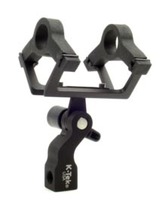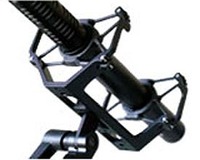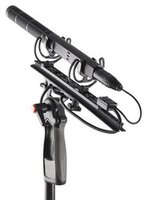Another shockmount on the market is PSC's Universal Shock Mount. It is inexpensive and uses two rubber O-rings to sandwich the mic at either end. A lot of people swear by them.
K-Tek makes a few excellent shockmounts: namely the K-SM, K-MT, K-GPS, and their variations.
 The K-SM is sort of the flagship of the line (seen left). It uses two polymer mounts that are sort of like an inverted V with a circular center. The center ring stretches to firmly seat most popular shotgun mics, and the inverted supports offer excellent support. This mount is available in standard length, and a short length (K-SSM) for shorter mics.
The K-SM is sort of the flagship of the line (seen left). It uses two polymer mounts that are sort of like an inverted V with a circular center. The center ring stretches to firmly seat most popular shotgun mics, and the inverted supports offer excellent support. This mount is available in standard length, and a short length (K-SSM) for shorter mics.
The K-CAM-SM is the same mount, but with a flat camera shoe instead of a 3/8 threaded swivel mount.
 The K-MT and K-GPS do not utilize the inverted V mounts, but instead rely on a complete 4-point suspension. The heart of both mounts is the K-Tek K-SUS mic suspenders, which can be described as a polymer ring with four loops extending out. Each of the loops is secured to the metal frame of the shockmount. This system provides the utmost in isolation, though not as much hard shock absorbtion.
The K-MT and K-GPS do not utilize the inverted V mounts, but instead rely on a complete 4-point suspension. The heart of both mounts is the K-Tek K-SUS mic suspenders, which can be described as a polymer ring with four loops extending out. Each of the loops is secured to the metal frame of the shockmount. This system provides the utmost in isolation, though not as much hard shock absorbtion.
In plain English, what that means is that the K-SM is better for hard handling, such as ENG "run 'n gun;" and the K-GPS is better for subtle handling of extremely sensitive mics, such as studio feature films & TV. Kind of like choosing shocks for a car: some are better for high speed highway and some are better for rough bumps and rugged terrain.
The K-MT is less expensive, but not as heavy duty, as the higher end K-GPS (seen right).
Shockmounting a miniature microphone such as a lavalier is easier than one might imagine. It is very common to mount small mics onto table tops, walls, and all sorts of props. A short strip of cloth camera or gaffers tape, loosely wadded into a loop or a ball, will suffice. Lavalier mics have very little mass, so they are easily supported by a single thickness of tape. The cloth and adhesive gel of the tape are very efficient at dampening vibration.
An adjunct of shockmounting the microphone is to shockmount the potential source of noise and vibration. The Hollywood industry uses a material known as "foot foam" to cut down obvious trouble areas. Foot foam is adhesive backed, thin neoprene rubber which can be cut and affixed to shoes, boots, glassware, table tops, bases of mic stands, etc.
Foot foam is cheap and expendable; your dialogue track is not.
 Moving up the scale in terms of quality and price brings us to dedicated pistol-grip shockmounts. An example of which is the Rycote Modular Suspension, shown left.
Moving up the scale in terms of quality and price brings us to dedicated pistol-grip shockmounts. An example of which is the Rycote Modular Suspension, shown left.
Pistol-grip shockmounts are usually designed to accommodate just one or two specific microphones. The mic mounting clips are usually specific in diameter; 19mm and 21mm are the most common. The spacing from front clip to back clip is engineered for specific mic length and mass. The rubber mounts supporting the clips are also optimized for a particular load.
The pistol-grip handles themselves are drilled and tapped to accommodate the standard 3/8" thread found on boompoles. Some of the shockmount manufacturers also offer short boompole mounting yokes in lieu of the handles, but the majority of users prefer the handles.
The pistol grip shockmounts sell for around a couple hundred, give or take, depending on manufacturer, model, and your personal discount.
Of course, another expedient solution is to use a simple handgrip with a built-in 3/8 stud on the end. Just screw it into a standard 3/8 shockmount and now you have a pistol grip shockmount!
But to be honest, most of the pistol grip type shockmounts that one sees here and there are actually just the receiver portion of full zeppelin systems, but without the zeppelin windscreen attached. Very few people purchase pistol grip shockmounts by themselves.
Pistol-grip shockmounts are manufactured by K-Tek (U.S.), Rycote (U.K.), Rode (A.U.), and Sennheiser (Germany).
Over the years, Rycote and K-Tek have been very responsive to the needs of the industry, and keep refining their products into what are generally acknowledged to be the standards of the motion picture and video production industry. A newcomer on the scene is Rode, who also manufacture a full line of shockmounts and blimp windscreens.
One quick note about shockmounts and thread sizes. It has been mentioned that shockmounts come equipped with some sort of mounting hole or adapter for use with fishpoles and mic stands. There are three different thread sizes that you may encounter: 3/8", 5/16", and 5/8".
The current standard thread for fishpoles is 3/8". The slightly smaller 5/16" used to be the standard in Hollywood, but has pretty much been replaced by the more popular 3/8". Older fishpoles and pistol-grip handles may require a simple adapter for use with 3/8".
The larger 5/8" thread size is the standard for mic stands and goosenecks. Most mic clamps are threaded for 5/8", although some are also supplied with a 3/8" insert adapter.
